Биологические науки. Рубрика в журнале - Бюллетень науки и практики
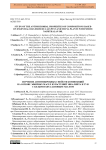
Статья научная
Cosmetic and medical oils have been widely used in medicine and cosmetology for many years. The main function of medical oils is to be a carrier in medicinal preparations. But in many cases, they perform a therapeutic function at the same time. It should be noted that for obtaining medical and cosmetic oils, low-sulfur and low-paraffin oils are more appropriate. In the context of the conducted research, the antimicrobial activity of various combinations of essential oils obtained from eucalyptus and thuja plants with therapeutic white naphthalan oil taken as a control variant was studied to clarify the effective bactericidal action mechanism. In the preparation of these compositions were prepared with the addition of therapeutic white naphthalan oil as the main component, and in addition, essential oil separated from eucalyptus and thuja plants in the ratio of 1:0,04:0,08:0,1 was analyzed for their antimicrobial effects on 4 microbes ( Pseudomonas aeruginosa, Staphylococcus aureus, Escherichia coli, Candida albicans ). Medicinal and cosmetic products were determined according to the received antimicrobial effective compositions.
Бесплатно
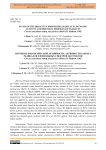
Статья научная
Human beings have used plants as medicine for various health cause of years. Plants are widely used in the traditional medicine of different countries and are a source of strong drugs. To evaluate research some bioactive properties of the extract of the Crocus cancellatus subsp. mazziaricus (Herb.) B. Mathew, 1982 the antioxidant activities of these extracts were analyzed by means of cleaning methods (DPPH, ABTS scavenging activity), β-carotene/linoleic acid test system and FRAP activity. Phenolics and flavonoid contents as the equivalents of gallic acid, quercetin respectively. The phenolic content of the extracts was analyzed using HPLC. Brine shrimp lethality test was applied to analyze cytotoxic activity. The obtained results indicated that the highest phenolic compound ferulic acid with 2376.2±0.00 µg/g was in extracts. The highest total phenolic and flavonoid were found in the ethanolic extracts. The aerial part-methanol extract exhibited the highest antioxidant capacity and the corm acetone extract the highest amount of ferric reducing power activity. Among the four different extracts, the acetone extract showed the highest amount of radical scavenging both corm and aerial parts. The brine shrimp lethality assay of bulb ethanol extract has showed good cytotoxic with LC50 of 320.535 μg/mL. This study will be a source for future studies.
Бесплатно
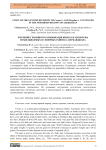
Статья научная
Cranberry and medlar are common in the Guba, Gusar, and Sheki regions of Azerbaijan. A study was conducted to determine the habitats of wild growing forms and biomorphological features. Identification was carried out based on molecular markers. A comparative study of the biomorphological characteristics of genotypes, economic indicators, pomological analysis and assessment of similarity by quantitative indicators was carried out.
Бесплатно
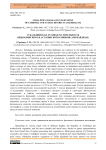
Subalpine grassland vegetation of Yardimli and Astara districts (Azerbaijan)
Статья научная
Subalpine grasslands of Talish highlands are common in the subalpine zone of Yardimli and Astara highlands at lawny mountain-meadow soils at the height of 1750 m to 2400 m above sea level. During the carried out ecological-geobotanical research, it has been determined 3 formation classes, 5 formation groups and 11 associations. In parallel with the study of type composition and structure of phytocenosis found in the area of investigation, it has been also determined endemic species, productivity of formations, and intensification of degradation at soil-plant coverage of some lawny subalpine grasslands, decrease in abundance and productivity of forage crop. Currently, for the purpose of the improvement of natural phytocenosis productivity, crop quality, protection of their genetic reserve and landscapes, as well as the vegetation study for solution of protection problems on the base of scientific means is of a great importance.
Бесплатно
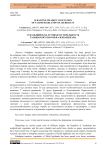
Subalpine meadow vegetation of Talish highlands of Azerbaijan
Статья научная
Subalpine meadow vegetation of Talish highlands has been spread over the subalpine zone of Lankaran highlands at lawny mountain-meadow soils at the height of 1800 m to 2500 m above sea level. During the carried out ecological-geobotanical research, it has been determined 7 formation classes, 12 formation groups and 20 associations. In parallel with the study of type composition and structure of phytocenosis found in the area of investigation, it has been also determined endemic species, productivity of formations, and intensification of degradation at soil-plant coverage of some lawny subalpine meadows, decrease in abundance and productivity of forage crop. Currently, for the purpose of the improvement of natural phytocenosis productivity, crop quality, protection of their genetic reserve and landscapes, as well as the vegetation study for solution of protection problems on the base of scientific means is of a great importance.
Бесплатно
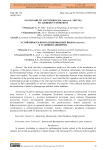
Sustainability of introduced Lonicera L. species to Absheron conditions
Статья научная
The study provides a comprehensive analysis of the results of the introduction of 13 species of the genus Lonicera L. in the conditions of Absheron. Information was obtained on the developmental biology of the introduced species Lonicera L., vegetation features, growth of shoots were studied. The results of many studies of the relationship between winter hardiness and the duration of the growing season are given. It was found that the vegetation can be divided into 6 phenological groups according to the start and end times of the vegetation, and the plants were selected for their sustainability to adverse conditions. The analysis of the collected material shows the distribution of plants by phenogroups and their winter hardiness.
Бесплатно
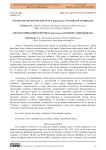
Systematic review of the genus Hypericum L. in flora of Azerbaijan
Статья обзорная
Among the widespread plant species in Azerbaijan, the genus Hypericum L. which dates back to the Cenozoic era and belongs to the family Hypericaceae takes special place. 80% of the total number of species belonging to the Hypericaceae family are concentrated in the genus Hypericum , which is distinguished by its many-sided areas of application, especially in the pharmaceutical, decorative and dye industries. This genus is considered one of the largest genera of flowering plants in terms of species diversity (22%). Although research on the systematics of the genus Hypericum has been conducted by many scientists around the world, the general characteristics and taxonomic composition of the species distributed in the flora of Azerbaijan have not been studied for the last 50 years. As a result of our research, it was determined that there are not 15 species, but 19 species, 1 subspecies and 1 variety belonging to the genus in the flora. The characteristics, descriptions and synonyms of sections, species, subspecies were given.
Бесплатно
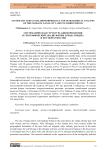
Статья научная
In the given article, the flora of Ganja city and its surrounding areas was studied, the plants were systematically, biomorphologically, geographically, ecologically, and endemically analyzed. The article also analyzed rare and endangered plants on scientific basis. In the researched region, 68 families, 244 genera, and 441 species of plants were identified. It is reported that the basis of the flora composition of the territories is angiosperms, the leading families of which are Poaceae with 38 genera (15.6%), 63 species (14.3%), Fabaceae 23 genera (9.4%), 48 species (10.9%); Asteraceae is represented by 15 genera (6.6%), 35 species (7.9%). It was determined that the composition of the flora of the study area is dominated by perennial grasses with 194 species (44%).
Бесплатно
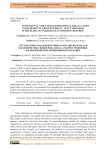
Статья научная
The article presents data on the systematical structure, ecological groups, and areal classes of Rosa L. genus spread in the flora of the Nakhchivan Autonomous Republic. As a result of researches in the Nakhchivan Autonomous Republic, the concept of 30 species of Rosa L genus was developed and spreading of these species by vertical heights, as well as geographic range classes based on regional and zonal principles, were determined.
Бесплатно
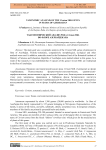
Taxonomic analysis of the Cirsium mill. genus in flora of Azerbaijan
Статья научная
The main goal was a systematic analysis of the Cirsium Mill. genus (Asteraceae) in flora of Azerbaijan. Floristic-systematic, comparatively morphological, ecological and other methods were used. In addition, materials stored in the Herbarium Fund of the Botanical Institute of Ministry of Science and Education, Republic of Azerbaijan were studied related to this genus. As a result of the research, it was established that 31 species of the genus Cirsium Mill. are widespread in the flora of Azerbaijan.
Бесплатно
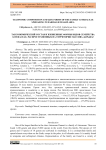
Taxonomic composition and life forms of the family Asteraceae spreading in Daridagh massif area
Статья научная
The article provides information on the taxonomic composition and life forms of the Family Asteraceae Dumort, which is widespread in the Daridagh Massif area. During our research, 43 species belonging to 23 Genera of the Family Asteraceae Dumort spreaded in the Daridagh Massif area. Also, a comparative analysis of the number of species belonging to the Family and their life forms were studied. According to the analysis of the number of species of the Genera Helichrysum Mill. - 2 (4.65%), Taraxacum Wigg. - 2 (4.65℅), Centaurea L. - 3 (6.97%), Carduus L. - 3 (6.97%), Achillea L. - 3 (6.97%), Scorzonera L. - 6 (13.95%) and Tragopogon L. - 8 (18.6%) species are the main predominant species in the Daridagh Massif area and are represented by 27 (62.79%) species. The remaining Genera are monotype and consist of 16 (37.20%) species.
Бесплатно
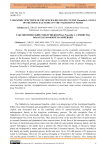
Статья научная
The presented article provides information on the systematic composition of the species belonging to the Potentilla L. genus, which is spread in flora. During the comparative analysis of the collected herbarium materials and literature sources, it was found that the Potentilla genus of the Rosaceae family is represented by 17 species in the territory of Nakhchivan, and information about the current status of those species is reflected in the article. The article also studied the ecological groups, geographical elements, and altitude zones of species belonging to the genus Potentilla L. of the Rosaceae family.
Бесплатно
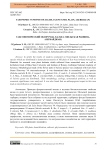
Taxonomic synopsis of salsola genus (Mil Plain, Azerbaijan)
Статья научная
In article the results of analysis conducted on bioecological features of Salsola species which are distributed in desert phytocoenosis of Mil plain of Kur-Aras lowland were given. Materials for research were plant herbaria which collected from researched area, as well as herbarium funds of Baku State University and Institute of Botany Azerbaijan National Academy of Sciences. Morphological study of the flower parts of Salsola species was conducted with Carl Zeiss Stereo Discovery V4 stereomicroscope. It was determined that in researched area 10 species ( Salsola australis R. Br., S. tragus L., S. paulsenii Litv., S. soda L., S. nitraria Pall., S. incanescens C. A. Mey., S. dendroides Pall., S. ericoides Bieb., S. nodulosa (Moq.) Iljin, S. foliosa (L.) Schrad.) of Salsola genus are distributed. Their morphology, ecology, systematical position, as well as economic significance were analyzed. It was also found that an anthropogenic impact in this area leads to desertification of landscapes.
Бесплатно
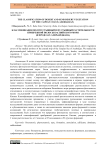
The Classification of Desert and Semi-desert Vegetation of the Caspian Coast (Azerbaijan)
Статья научная
The article outlines the fractional classification of the semi-desert, desert vegetation covers of the studied territory of the coastal strip of the Caspian Sea of Azerbaijan. We studied the phytoceonological indicators of communities related to forests, shrubs, semi-desert, desert, vegetation. 3 types, 12 formation classes, 69 formation groups and 92 associations are distinguished.
Бесплатно
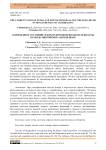
The current state of flora and phytocoenosis along the Kura river in Mingachevir city (Azerbaijan)
Статья научная
During the geographical analysis of the flora in the area surrounding the city of Mingachevir, situated on the banks of the Kura River in Azerbaijan, a total of 158 species of angiosperms were recorded. These were found to be represented in 28 families and 79 genera. As a result of the analysis, a flora conspectus was prepared. During the conducted research, six types of vegetation were identified along the Kura River in Mingachevir city. These vegetation types include bozghir (dry steppe), semi-desert, halophyte desert, thicket-grass, wetland, and forest. The researchers found that these vegetation types are represented by eight formation classes, nine formation groups, and ten associations. The research included the species composition of the identified formations and carried out geobotanical descriptions. We also evaluated the economic importance of phytocoenosis by determining the main fodder plants and the modern state of the terrestrial flora and phytocoenosis.
Бесплатно
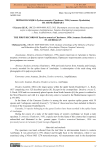
The first record of Dysdera armenica Charitonov, 1956 (Araneae: Dysderidae) in Azerbaijan
Статья научная
Dysdera armenica Charitonov, 1956 previously known from Armenia and Georgia, is newly recorded for the spider fauna of Azerbaijan. A redescription of the male along with photographs of its palp are provided.
Бесплатно
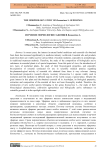
The morphology study of Rosmarinus L. seedlings
Статья научная
In recent years, the interest in natural herbal medicines and essential oils obtained from them has increased significantly in medicine industry worldwide. Essential oils and products made from them are widely used in various fields of modern medicine, especially in aromatherapy, in traditional treatment methods. Therefore, the study of the composition of biologically active substances in essential plants is of special importance. From this point of view, the introduction of new types of medicinal plants, the study of their bioecological properties, and especially the expansion of research conducted for use in scientific medical practice regarding the pharmacological activity of essential oils obtained from them is very relevant. Among the mentioned prospective research objects, rosemary (Rosmarinus L.) species widely used in medicine and folk medicine in different regions of the world occupy a special place. Despite the great interest in this plant and the obtained essential oil in Azerbaijan, its biological properties, extraction and composition of the essential oil have not been thoroughly studied. Therefore, the introduction of new useful species belonging to the genus Rosmarinus L., the study of their bioecological characteristics, cultivation agrotechnics and biologically active substances on scientific grounds is in the spotlight with its relevance.
Бесплатно
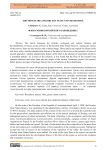
The moss flora of Korchay state nature reserve
Краткое сообщение
The article discusses the floristic, ecological and cenotic features and the distribution of mosses in the territory of the Korchai State Nature Reserve. Among the mosses of the reserve, there are also species with a limited range. Those species are typical for silicate rocks and stony rocks. Another characteristic feature of the relief of the reserve is the presence of traces of ancient glaciation. Another characteristic feature of the relief is the absence of watersheds similar to a smoothed plateau. As a result of the research, it was found that the flora of the research area contains elements and relics from the last stages of the ancient Cretaceous period (3rd period). Relict species are pages of geologic history that reveal patterns of flora distribution.
Бесплатно
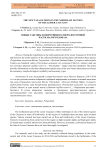
The new taxa of ferns in the northeast section of the Lesser Caucasus
Статья научная
During the expeditions in the north-eastern part of the Lesser Caucasus in 2014-2016 and based on the results analysis of the collected herbarium and descriptor information three species ( Polypodium interjectum Shivas, Polystichum ×illyricum (Borbás) Hahne, Cystopteris anthriscifolia Fomin), one botanical variety ( Polystichum aculeatum var. aristatum (Christ) A. Askerov) and one new ecotype ( Adiantum capillus-veneris L., “Dwarf plant - Ganja”) has been identified. The article provides information on the three-dimensional spatial areas of the sites where these plants are found, the taxonomy, morpho-biological variability and taxonomy types.
Бесплатно
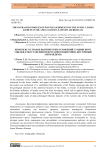
Статья научная
Biostratigraphic characteristics of the Pontian deposits of Gobustan are given based on the materials of the Sundu cavern. The systematic composition and characteristic complexes of ostracods for the lower, middle, and upper sub-tiers are revealed. Biostratigraphic dissection of the section was performed. It is established that sediments of the Pontian regiostage take part in the geological structure of the anticlinal structure of the Sundu. A scheme of dismemberment of the Pontian sediments of Sundu cavern has been developed, which can be applied during further geological exploration in other areas of the SE of Gobustan. The obtained results can also be used for biostratigraphic study of deep-submerged Miocene deposits of the western side of the Southern Caspian.
Бесплатно

